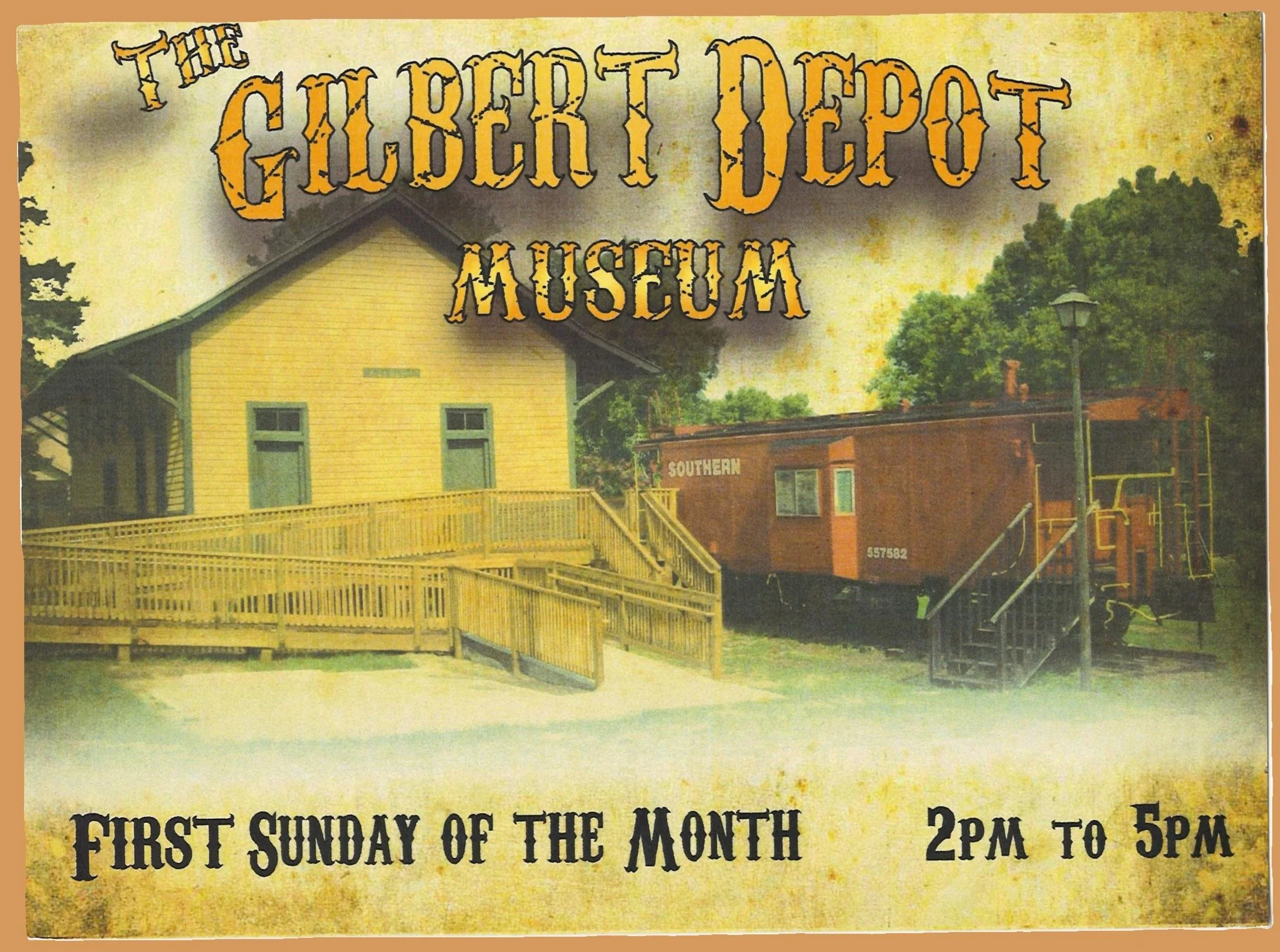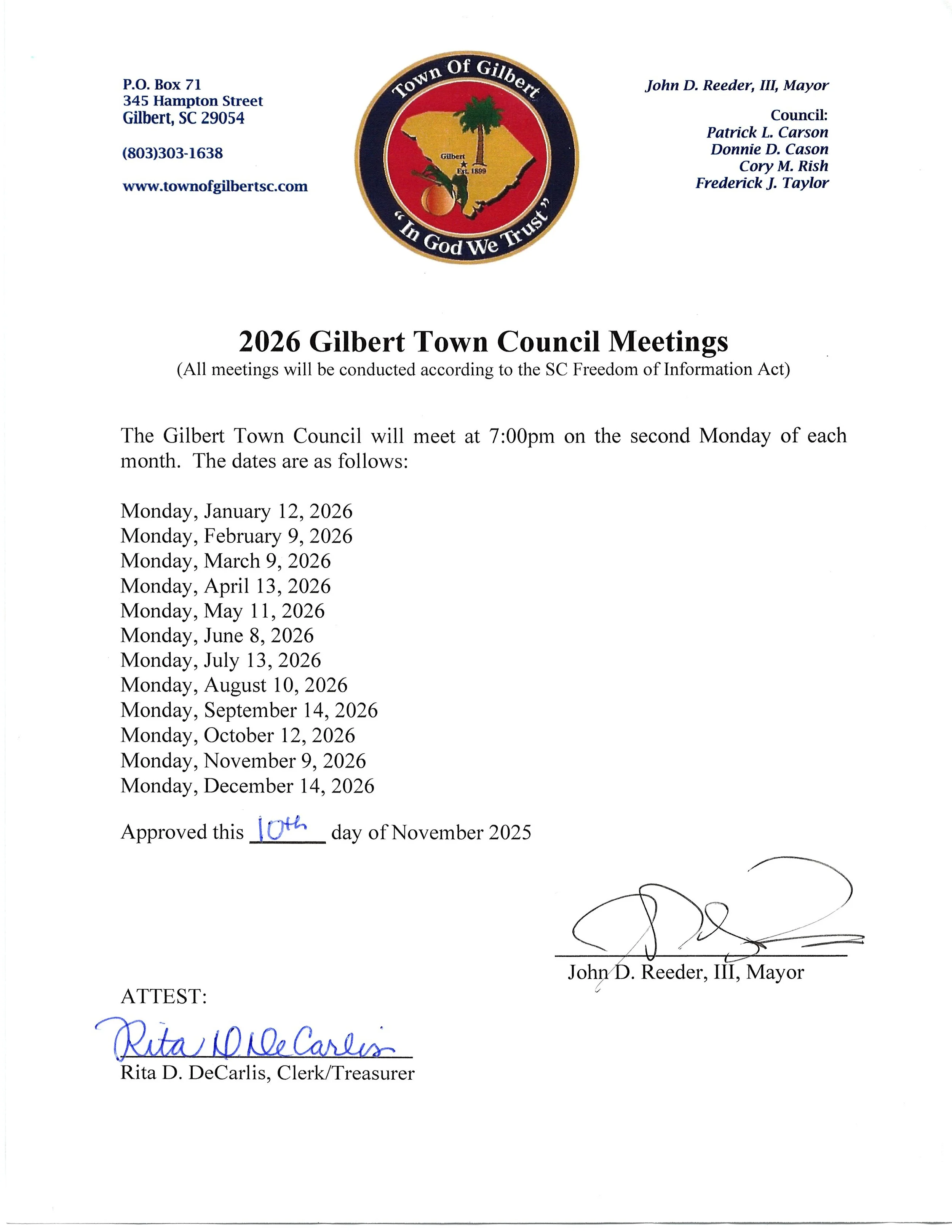How We Began - Chapter One
Earliest History
Based on early documentation by Spanish and English explorers, it is believed that the area which is now Gilbert would have been controlled by the Cherokee Indian nation. The Time period was around 1670 according to Mr. Tom Charles of the South Carolina Institute of Archeology and Anthropology. Several artifacts from this period have been found within the town limits, particularly near Juniper Springs.
Doctor Chester Depratter of the South Carolina Institute of Archaeology and Anthropology, dated one arrowhead to be 7,000 years old. It was classified as a Morrow Mountain Projectile Point. These types of arrow points were first found in North Carolina. Several pieces of pottery were dated approximately 2,000 years old. The Pottery pieces are classified as Deptford Pottery. Pieces like these were first discovered in the Savannah area of what is now South Carolina.
Gilbert Hollow
In the year 1529, Martin Luther and his adherents protested and mad a declaration of dissent from the decree of Charles V and the Edict of Spires. Those in France who protested against the Catholic Church were called Huguenots or French Protestants. The Huguenots were not allowed to voluntarily leave their country to pursue religious freedom but, when the oppression and prosecution became too heavy to be endured, a great many of these people fled to England. Some continued their journey to America, where they had the freedom to worship God according to the dictates of their own conscience. In America there were none to “hinder nor make them afraid.” Finally, in the year 1680, the Emperor Charles gave free pass to the ship “Richmond” from France to America. In this ship came forty-five people, all home landed in South Carolina at Port Royal, near Beaufort, which at the time was included in the territory of Florida. Descendants of these forty-five people can still be found in South Carolina today.
Among the Huguenots who arrived in South Carolina were the names such as Dubs, Porcher, Seabrook, Gilbert, Gailliard, and Legan. The majority of these people settled in the lower part of what is now the State of South Carolina. The Gilberts and others came farther north. One of their descendants, Jonathan Gilbert settled just southwest of Columbia, near the place called Juniper Springs. The first use of the name of Gilbert began with the naming of Gilbert Hollow, after Jonathan Gilbert. His house was situated below the railroad crossing on what is now Waters Ferry Road. Juniper Springs was a landmark where Two Notch Road from Augusta, and Old Charleston Road (an old Indian trail) from Ninety Six to Columbia, intersected. Gilbert Hollow, in 1782, was the only named settlement between what was called “the Ridge” near Leesville and Granby, now Cayce. It was a favorite stopping place for travelers. (Source: The Weekly News, July 4, 1888.)
In an 1870 census the population of Gilbert Hollow and the surrounding Gilbert Hollow area, was 872, compared to neighboring Lexington, whose census was 1,563 persons.
Name Change
On August 7, 1872, according to post office records, Gilbert Hollow changed its name to Summit Point. It was changed back to Gilbert Hollow on July 20, 1876. We do not know why this change took place.
Gilbert Hollow to Lewiedale 1886
During the early 1800's Gilbert Hollow was a growing settlement. Several families were expanding and making a mark on this area. Samuel Lewie and his wife Nancy bore ten children in Gilbert Hollow between 1827 and 1846. The sons of Samuel and Nancy were Civil War heroes and striving businessmen. Col. Samuel P. Drafts and several of the Lewie sons were the first successful businessmen to stock goods to sell to the railway hands and to the people of the county.
By 1886, the Lewie family, the most prominent family in the area, made an effort to change the name of Gilbert Hollow to Lewiedale. This change occurred on February 4, 1886, with the official corporation of Lewiedale. The post office, newspaper, high school, Masonic Lodge and the liquor dispensary all accepted the name change. The name Lewiedale did not last long because the railroad refused to accept the change. The railroad was a strong economic force in small towns along the east coast. The name change would put Lewiedale between the two train stops of Lexington and Leesville. That would make all three consecutive stations begin with the same letter "L". At this time the railroad officials thought there would be too much of a chance for confusion in interpreting railway dispatches and orders. Therefore, all mail addressed to Lewiedale would not be accepted or carried by the railroad, and train tickets were refused to the travelers wishing to go to Lewiedale. Records show that the train schedule kept the name Gilbert Hollow.
The Editor of "The Weekly News," published in Lewiedale in 1886, was Wade Leaphart, who was also the Druggist at that time. Talton S. Sease had a prosperous farm and home near Hayes Crossing. Two of the more important buildings inLewiedale were the Methodist Church, founded by Dr. Solomon R. Lewie, of which the Rev. T.C. Ligon was pastor, and the Masonic.Hall. The local schools flourished under the direction of E.F. Bradford. The Lewiedale school was located near the Baptist Cemetery. Dr. Crosson was Lewiedales s physician. (Source: The Weekly News, 1886)
Dr. Crosson's house is still standing at the corner of Crosson and Hampton Streets and is occupied by Mrs. Estelle Novak today.
Mrs. Ganelle Harman of Lexington, furnished this newspaper information. she has a preserved copy of this newspaper. . The newspaper was found in a corner stone of the old Confederate Monument, in Lexington, SC The original monument was erected by the Ladies of Lexington, to honor the dead and wounded soldiers of the Civil War. This monument was located on the old Lexington Court House grounds. The monument was torn down and moved across the street, where the new court house is today.
The Old Confederate Monument, in Lexington, SC.
LEFT: The old Confederate Monument.
In 1889, the postmaster was J.F. Leaphart and the express agents (they handled the shipping and freight) were Messieurs Donly and Sease. The post office was in the corner of Donly and Sease's store.
In 1893, Lewiedale was the market for agricultural products for the surrounding county and also had a large lumber and naval store . A naval store sold products extracted from pine wood, including pitch, tar, rosin and turpentine. The name derived from the fact that those items were important in the shipbuilding business during the days of wooden sailing vessels. There were many outstanding businessmen contributing to the success of Lewiedale, including Col. Samuel P. Drafts, Dr. Solomon R. Lewie, Captain James H. Lewie, William H. DonlY and T.S. Sease. Captain David J. Griffith, Wade Leaphart, James F. Leaphart and E.F• Shealy did the largest amount of business in the area. Reed Keisler had a corn and grist mill and a mercantile business one half a mile north of Lewiedale, located below Price's Feed Mill at Twelve Mile Creek. Mr. Keisler was also Trial Justice for the area.
"Lewiedale was noted for the sociability, refinement and the open-handed hospitality of its citizens. The solidity, enterprise, and prosperity of its businessmen is most significant." (Source: The Lexington Dispatch , 1886)
Lewiedale to Gilbert 1899
In August of 1893, Lewiedale was a village of approximately 250 inhabitants. It was situated on the Charlotte, Columbia & Augusta Railroad. Then in 1889, the influence of the Lewie family died with Captain James Lewie.
On February 28, 1899, a petition was filed with the State Attorney General for a commission to register voters and to hold an election of incorporation. The petition was received and a commission was granted on March 1, 1899 to register voters for an election to be held on May 12, 1899. The election was to approve the incorporation of Lewiedale (Gilbert), and to elect Town Officials. Records indicate that the first registered voter, one J.F. Leaphart, age 48, was assigned registration number 1, on March 25, 1899. (Source: Gilbert Town Council Minutes, 1899)
Since then the town has been recognized by its citizens as Gilbert. The US Post Office did not officially recognize the name change until the spring of 1904. The name being adopted from the original Gilbert Hollow.
The Certificate of Incorporation for the Town of Gilbert






